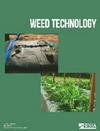水稻出生前和出生前施氟醚与现行标准的效果比较
IF 1.7
3区 农林科学
Q3 AGRONOMY
引用次数: 0
摘要
摘要随着植物对除草剂产生抗性,稗草的防治变得越来越困难。ROXY抗氟氧虫水稻(ROXY®水稻生产系统)已经开发,允许一种替代的行动模式来控制谷仓草和其他杂草。2021年和2022年,在阿拉斯加州柯尔特附近的松树研究站、阿拉斯加州凯泽的东北研究和推广中心以及阿拉斯加州洛诺克附近的阿肯色大学松布拉夫小农场研究中心进行了田间试验,以确定相对于目前标记用于水稻的除草剂,在苗期前或苗期后施用氟氧芬后的杂草控制水平和作物耐受性。在粉质壤土上,在种植后未发芽时单独施用1,120和1,680克氟虫芬,其对稗草的控制效果与单独施用336克氯马酮相当。尽管如此,对水稻的伤害往往比氯马酮更大,从20%到45%不等。在粘土上,1 680 g ha -1氟氧芬在苗期3周后对两个地点年的稗草的防治效果与单独使用氯马酮相当,但对水稻造成高达18%的伤害。在2叶稻生育期施用560 ~ 1680 g ha -1的氟氧芬,4个立地年中有3个立地年的稗草防治率≥85%。然而,对水稻的伤害从38%到73%不等。丙烯造成的危害是目前标记用于水稻的除草剂中最大的,占34%。由于在苗期后使用后观察到的伤害,氟氧芬应该用作植物苗期前除草剂,而不是苗期后除草剂。数据表明,如果作为出苗前除草剂使用,氟氧菊酯的施用量应为560克/公顷,以减少在粉质壤土和粘土上观察到的危害。本文章由计算机程序翻译,如有差异,请以英文原文为准。
Effectiveness of Preemergence- and Postemergence-Applied Oxyfluorfen in Rice Compared to Current Standards
Abstract Control of barnyardgrass is becoming increasingly difficult as plants evolve resistance to herbicides. ROXY oxyfluorfen-resistant rice (ROXY ® Rice Production System) has been developed to allow for an alternative mode of action to control barnyardgrass and other weeds. In 2021 and 2022, field trials were conducted at the Pine Tree Research Station near Colt, AR, the Northeast Research and Extension Center in Keiser, AR, and the University of Arkansas Pine Bluff Small Farm Research Center near Lonoke, AR to determine the level of weed control and crop tolerance following oxyfluorfen applied preemergence or postemergence relative to herbicides currently labeled for use in rice. When applied post-plant preemergence on silt loam soil, oxyfluorfen alone at 1,120 and 1,680 g ai ha -1 resulted in barnyardgrass control comparable to clomazone alone at 336 g ha -1 . Still, injury to rice was often greater than with clomazone, ranging from 20% to 45%. On clay soil, oxyfluorfen at 1,680 g ha -1 resulted in barnyardgrass control comparable to clomazone alone in both site-years at three weeks after emergence but caused up to 18% injury to rice. When oxyfluorfen was applied at 560 to 1,680 g ha -1 at the 2-leaf rice growth stage, barnyardgrass control was ≥85% in three of four site-years one week after treatment. However, injury to rice ranged from 38% to 73% for the rates evaluated. Propanil caused the greatest injury by a herbicide currently labeled for use in rice at 34%. Oxyfluorfen should be used as a post-plant preemergence herbicide rather than a postemergence herbicide due to the injury observed after a postemergence application. The data indicates that if used as a preemergence herbicide, oxyfluorfen should be applied at 560 g ha -1 to reduce the injury observed on silt loam and clay soils.
求助全文
通过发布文献求助,成功后即可免费获取论文全文。
去求助
来源期刊

Weed Technology
农林科学-农艺学
CiteScore
2.90
自引率
21.40%
发文量
89
审稿时长
12-24 weeks
期刊介绍:
Weed Technology publishes original research and scholarship in the form of peer-reviewed articles focused on understanding how weeds are managed.
The journal focuses on:
- Applied aspects concerning the management of weeds in agricultural systems
- Herbicides used to manage undesired vegetation, weed biology and control
- Weed/crop management systems
- Reports of new weed problems
-New technologies for weed management and special articles emphasizing technology transfer to improve weed control
-Articles dealing with plant growth regulators and management of undesired plant growth may also be accepted, provided there is clear relevance to weed science technology, e.g., turfgrass or woody plant management along rights-of-way, vegetation management in forest, aquatic, or other non-crop situations.
-Surveys, education, and extension topics related to weeds will also be considered
 求助内容:
求助内容: 应助结果提醒方式:
应助结果提醒方式:


